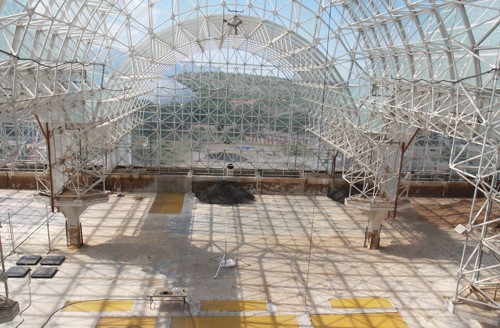Paper beats rock and plants eat rocks. Biosphere 2 will show how plants can eat rocks at a lecture on Saturday.
A discussion of the relationship between plants and rocks serving as a source for nutrients will continue the Biosphere 2 “”Let’s Talk Science!”” lecture series on Saturday.
Part of an outreach effort, the eight-lecture series will take place every Saturday until Dec. 4. Research faculty members were chosen to speak about their primary areas of expertise in an effort to reach out to the community and improve scientific literacy.
Soil chemist and assistant research professor Katerina Dontsova’s lecture, “”How can plants eat rock?”” will be held this Saturday.
The lecture’s focus is appealing to many, Dontsova said. “”Everybody knows about plants in their garden. How (they) get nutrients from the soil, particularly from rocks we often see in Arizona, might be of interest.””
The researcher recently received a grant from the National Science Foundation to do this work on microorganisms, plants and rock weathering.
Her work focuses on rocks’ transformation to secondary minerals, when elements are released that can be a nutrition source for plants.
She is also working on a larger, related Biosphere 2 project called the Landscape Evolution Observatory. It will explore interactions between biology, geology and chemistry and its effects on water movements.
It is a tool to bring public awareness to “”the important science done at the biosphere,”” said Hassan Hijazi, director of external affairs for Biosphere 2.
The series kicked off Oct. 9 and is on its third week. As the Biosphere enters the fourth year under UA administration, it’s “”a good time to revisit the significant research that’s being performed,”” said Matt Adamson, the Biosphere 2 senior program coordinator organizing the series.
Biosphere 2 receives 80,000 visitors a year, and people touring the center will be able to hear first-hand about the findings of research they see being conducted, Hijazi said.
At the lectures, in seminar style where participants are free to ask questions, live shots will be shown to the audience of where in Biosphere 2 the particular work presented is being done.
Adamson predicted a heavily research-oriented facility emerging over time, with visitor tours concentrating on the work being done more than the history of the site.
The lecture series’ championing of science awareness is important, Dontsova said. She used climate change as an example of research that has been “”long accepted by scientists,”” and a “”large fraction of the public”” still doesn’t believe it to be true.
“”It’s very important to tell the public about research that’s going on. (If the public) is more involved, (they) can make informed decisions about information they receive,”” she said.









